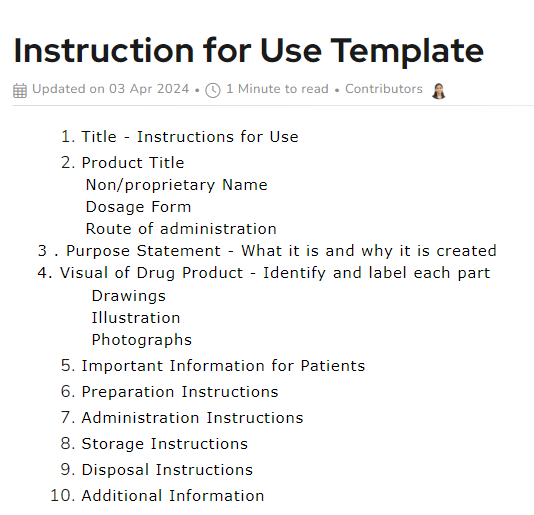Have you ever wondered how these lab technicians get training to use the new devices?
Though they attend in-person training, they need user manuals handy that comply with regulatory requirements and compliance standards.
Who should deploy these instructions to use?
The manufacturer is responsible for analyzing the security reports and developing instructions for use.
Failing to provide clear and comprehensive IFU can lead to frustration and inadvertently misuse of the tool, leading to severe complications.
So, the big question is how to write a comprehensive set of instructions for use.
What Is An Instruction for Use?
When machinery is released into the service market, it should be sold with IFU. IFUs carry information to the user on the product’s intended purpose, proper usage instructions, and precautions to be taken while installing or using the product.
The IFU is prepared by the applicant ( manufacturer), and it is reviewed and approved by FDA
The content on IFU can vary widely depending on the complexity of the product and associated risk in handling. For example, Not only medical devices but also industrial machinery, household appliances, and electrical goods all come with IFUs.
What Is The Purpose Of Instructions For Use?
Mainly used in the medical industry, IFUs are created for prescription drugs and medical devices.
IFUs are included in all devices, even if an existing device exists.
Let us understand this with an example.
Your company manufactures a medical device and now has come out with a better version. The difference between the two devices includes slight modifications. These small changes that are intended to improve the quality of the product even when the original is still on the market also need to be included in the detailed description of the device.
The Code of Federal Regulations specifies that, except for Class I and Class IIA, all other medical equipment, devices, and accessories sold for clinical use must include an IFU. The exception is given because it can be used safely without any instructions.
Class I products are low-risk devices and include
- Bandages
- Non electric wheelchairs
- Handheld surgical instruments
Class IIA products account for 43% of medical devices. They generally impact a patient’s well-being more through longer periods of sustained contact. Some of the products are:
- Syringes
- Blood Pressure Cuffs
- Powered Wheelchairs
- Contact Lenses
- Pregnancy kits
- Software used as Diagnostic Tools
The FDA generally accepts and includes the format below in sequential order:
- Table of contents
- Glossary
- Purpose of the device
- Set up instructions
- Operating instructions
- Importance of the need to monitor the activity of the device
- Cleaning instructions
- Storage instructions
- Troubleshooting information
- Index
Benefits Of Having An Effective IFU
An effective IFU is vital not only to a manufacturer’s products but also to people’s lives. When you read any prescription drug or supplements or use a medical device, it is the directions written on an IFU that may act as a life changer, saving by preventing an injury or any harm, including death.
- Enhanced Safety
When the safety instructions are laid out clearly, users will understand how to use medical devices safely. It also helps in reducing the risk of misuse or injury.
- Minimizes Liability
Thorough instructions can help mitigate liability risks for manufacturers as they state that reasonable steps have been taken to inform the users about the product.
- Reduced Errors
When the instructions for use are clear, the risk of errors on a user’s part is reduced as the proper dosage is mentioned or the device is set up. It also helps improve the treatment outcome.
- Facilitate User Adoption
When an IFU is user-friendly, it automatically makes it easier for a user to adopt the product. It also leads to better usage and word-of-mouth publicity.
- Training and Education
IFU is just not any document. It acts as an educational resource for healthcare professionals, caregivers, and patients. It helps them understand how to use the product effectively.
- Increased Trust
When the IFU is well crafted, it instills trust in the manufacturer. It also shows the manufacturer’s commitment to adding value by caring for the smallest details.
- Improved User Experience
When a user can follow the instructions well, it may add to their smooth experience, which may further lead to increased confidence in the manufacturer.
How To Write An IFU?
To create and organize the content and format of the IFU, you need a systematic process. Before you begin writing instructions or directions for use, you need to understand the 7 top things to consider.
- Intended Use
- Usability Engineering Process
- Risk Management Process
- Standard Documents
- General Safety and Performance Requirements
- Legal Requirements
- Product Requirements
Let’s dive a little deeper to understand these seven considerations
1. Intended Use
The intended use is what you, as a manufacturer, say about your medical device. It is defined as:
“intended use intended purpose use for which a product, process, or service is intended according to the specifications, instructions, and information provided by the manufacturer. “
– ISO 14971:2019, 3.6
What you must do is adjust the language to your audience. Say, for example, if the device is going to be used by medical professionals, then it can have medical language. If your users are regular people with varying cognitive abilities, the language may be adjusted accordingly.
Your instructions for the use of medical devices should be aligned with the intended use.
2. Usability Engineering
From a regulatory point of view, and 62366-1:2015 standard, “strictly focuses on applying the usability engineering process to optimize the medical device usability as it relates to safety”.
You can use the usability engineering process to achieve user-friendliness. User specification and thoroughly performed risk management will provide input as to
- What information to put into your instructions for use
- Any requirements on that information
- How the information is presented
The usability engineering process focuses on the user interface and safety of the device.
3. Risk Management
Besides focusing on the life cycle phases, the risk management process also focuses on the aspects of medical devices. It not only includes risks from regular use but also any possible misuse.
- A simple warning in the IFU is not accepted as a way of reducing risk
- To reduce risk, put it on the information on the product
- Ensure this information is repeated in the IFU
4. Standard Documents
You need to look at at least two particular standards when creating instructions for the use of medical devices
- EN 1041:2008 – EN 1041 and ISO 20417 specifically describe the information that must be provided by the manufacturer and would most often be found in the instructions used.
- EN ISO 15223-1:2016 – The 15223-1 contains symbols used on medical devices, particularly on the label. Make sure you explain the symbols in the instructions for use.
The FDA has issued guidance documents according to best practices on how to write instructions for users and labeling. They are excellent guides for anyone trying to write instructions for the use of medical devices.
5. General Safety and Performance Requirements
Found in Annex I of the Medical Device Regulation, the general safety and performance requirements contain several sections specifying information that must be found in the instructions for use. For example, it requires you to include,
- The registered trade name of the device
- The registered trademark of the manufacturer
- The registered address of the place of business
- An indication that the device contains a medicinal substance (human blood or plasma or tissues or cells of human origin, or tissues or cells of animal origin or their derivatives)
- The CE mark (the product is in the market other than as an investigational device)
Check out our blog: Medical Device Documentation
6. Legal Requirements
Usually full of trademarks, a legal department may have opinions about your instructions for use. It is better if you include
- Various types of disclaimers
- Copyright statements to prohibit unauthorized copying
- Acceptable communication regarding the legal relationship between the customer and the manufacturer
7. Product Requirements
Most newly developed medical devices use the design inputs established at the onset of the project. If this is also the case with your device, you may include them in the product specification, giving the user information on things such as:
- Weight
- Dimensions
- Operating temperatures
- Accuracy of measurements
- EMC an immunity
- Other important technical aspects
Now that you understand the requirements for directions for use let us now get to how to write an IFU
Schedule a demo with one of our experts to take a deeper dive into Document360
Book A Demo
How To Write An IFU?
Instruction for Use needs to be clear, easy to understand, in a step-by-step hierarchy. Make the content easy to consume by formatting it well by adding headings, sub-heads, paragraphs, listicles, steps, sections, and more. The more clarity there is, the easier it will be to comprehend.
Here’s an example of how an IFU can look like


It is recommended that you
- Use active voice
- Write short steps
- Use images to illustrate
Understand your audience, requirements, and preferences, and then write for them.
Font and Formatting
Fonts from the sans-serif family, such as Verdana and Arial, work best for IFUs. And font size 10pt or above
You can use font size 8pt. or above for
- Name and place of business (manufacturer, packer, or distributor)
- Verbatim statement (This “Instructions for Use” has been approved by the U.S. Food and Drug Administration)
- Date of approval or revision of the IFU by the FDA
Other things to consider
- Write INSTRUCTIONS FOR USE in uppercase letters and in bold
- Product titles, Headings, Step numbers, and Figure titles are also in bold
You can refer to Instructions for Use – Patient Labeling for Human Prescription Drug and Biological Products and Drug-Device and Biological-Device Combination – Content and Format for further guidance.
Editing, Proofreading, and Iteration
Write your content, take a break, and then proofread. Look for typos or grammatical errors, change confusing sentences to simple sentences, and fine-tune your document. Creating an error-free instruction manual can help you leave a good impression on your user.
User Feedback
If possible, listen to your audience by encouraging users’ feedback. Use constructive criticism to refine your content.
Write an IFU and Not a User Manual
Make sure you write an IFU and not a user manual. A user manual is a comprehensive reference on how to operate and maintain a product. An IFU is written to accomplish a specific task, focusing on performing tasks on said medical device.
Check out our video, AI-Powered Healthcare Knowledge Base for IFUs:
Choose The Right Tool For Writing An IFU
Medical devices can be complex. And writing an instructions manual may be more so. It could require users to understand specific storage, use, or disposal information. Optimally, it is best to have the most intuitive design possible so that users can understand how to use it. However, it is not always possible. IFUs help manufacturers to convey the intended information while supporting safe and effective product use.
The best tool to write an effective IFU is a CCMS (Component Content Management System) that offers features such as
- Content Management
- Structured Authoring
- Support to Localization
- Collaboration Features
- Advanced Analytics and Reporting
- Compliance with Regulatory Measures and more
Also Read: 9 Best Work Instructions Software for 2024
Why Document360?
Document360 lets you create IFUs with a clear structure and hierarchy. Eddy, the AI Concierge helps users quickly find the most accurate information. Also, you can add images, screenshots, and drawings to your document and easily make changes to your IFU. It is easier to update the document with a version control feature, keeping track of all updates. All this and more makes it easier for your users to find the information they need without going through any friction points. Create and manage your IFU documentation more efficiently.


Conclusion
An unsafe product use due to misleading instructions can cause injuries, and manufacturers can be held liable for it. Manufacturers in today’s world must create online help documentation to help clients with questions regarding their medical devices.
- Prioritize user safety
- Warn users about potential hazards
- Provide clear instructions on how to manage the device
A single adverse event can disturb the equilibrium of your work, so play it safe and always include comprehensive safety information.
An intuitive SOP software to easily add your content and integrate it with any application. Give Document360 a try!
GET STARTED


Frequently Asked Questions
-
What is an IFU?
An Instructions for Use document, IFU provides clear and easy-to-understand instructions on how to use a medical product or device best and safely. The IFU must include the device’s intended purpose, description, warning, maintenance, and disposal instructions. It should also include the manufacturer’s contact information in case a user has any queries or issues.
-
Does the FDA require an IFU?
Yes. The FDA requires manufacturers of medical products and devices to provide an IFU with specific instructions on how to effectively use, take care of, and dispose of it.
IFUs are controlled and mandated by the FDA (Food and Drug Administration). All medical manufacturers need to provide detailed IFUs to consumers. Also, a standard set by the Association for the Advancement of Medical Instrumentation (AAMI), “ANSI/AAMI ST79:2017 states that the current written IFU should be accessible, reviewed, and followed. If no specific written IFU is available, the manufacturer should be contacted and requested to provide a documented cleaning method.”
-
Are IFUs applicable to both hardcopy and eIFUs?
Yes. the IFU symbol (5.4.3) applies to both hard and soft copies. However, eIFU is not specified in the Medical Device Rules 2017.
-
Is an IFU applicable to a low-risk medical device?
No. Several low-risk medical devices come without an IFU.
-
What does an IFU need to include?
An IFU must include a detailed description of a medical device. The instructions must be laid out and any differences between that of your device and that of your competitors or the previous version of your same device should also be included.
Some of the key elements to be included are
Device description, specification, accessories, and variants
Design and manufacturing information
Label and packaging information
Instructions for use in local languages where the device will be sold
Product verification and validation
General safety and performance information
Identify all sites where design and manufacturing activities are performed
Pre-clinical and clinical data
-
What are the best practices to write an IFU?
Some of the best practices you should follow when writing your medical device IFU documentation include
Prioritize clarity and understanding
Provide visual aids for complex concepts
Follow content hierarchy for easy navigation
Ensure easy readability of the document
Maintain adherence to regulations
Use an AI-powered documentation tool






